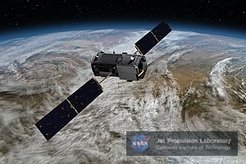NASA CO2 monitoring satellite OCO-2 successfully launched

Earlier today MPI-BGC scientists were again watching anxiously as NASA’s latest scientific satellite, OCO-2, was successfully launched from Vandenberg Air Force Base in California after the launch had to be scrubbed yesterday for technical reasons.
“OCO” stands for the Orbiting Carbon Observatory, but also represents the molecule of the gas it plans to measure: carbon dioxide (OCO = Oxygen-Carbon-Oxygen). OCO-2 should be able to measure the global distribution of column-integrated carbon dioxide with unprecedented spatial coverage and resolution. The hope was the same for its predecessor, OCO, which was unfortunately lost during a failed launch in 2009.
Several scientists from our institute are taking part in the project. The Atmospheric Remote Sensing group, led by Dietrich Feist, is operating one of the ground-based stations of the Total Carbon Column Observing Network (TCCON: http://www.tccon.caltech.edu) on Ascension Island. Just like OCO-2, the TCCON stations measure the concentration of CO2 not at the surface, but averaged over the whole thickness of the atmosphere. These ground-based stations provide a unique reference network for the calibration of spaceborne atmospheric measurements, not only those of OCO-2, but also earlier sensors such as TANSO on GOSAT (Japan) or SCIAMACHY on Envisat (ESA). The station on Ascension Island, lying in the remote tropical Atlantic between Africa and South America, is particularly well situated for the calibration of satellite measurements over the ocean. A team was even sent to the site to ensure everything was in full operation before the launch.
As for the measurements themselves, they will be used in atmospheric transport modeling studies as soon as they become available. In our institute this work will largely take place in the Satellite-based Remote Sensing group of Julia Marshall. These new measurements will help to constrain the global distribution of carbon dioxide surface sources and sinks. Compared to the existing surface-based measurement network, and even the currently operating satellite sensor TANSO, OCO-2 will provide information on significantly finer spatial scales, giving us information about where exactly carbon is being taken up and released. Another promising scientific byproduct delivered by OCO-2 is plant fluorescence, which is a direct measure for plant photosynthesis. This will provide some new insight about the terrestrial carbon cycle, by separating the processes of photosynthesis (resulting in uptake of carbon by plants) and respiration (whereby carbon dioxide is released from plants).












